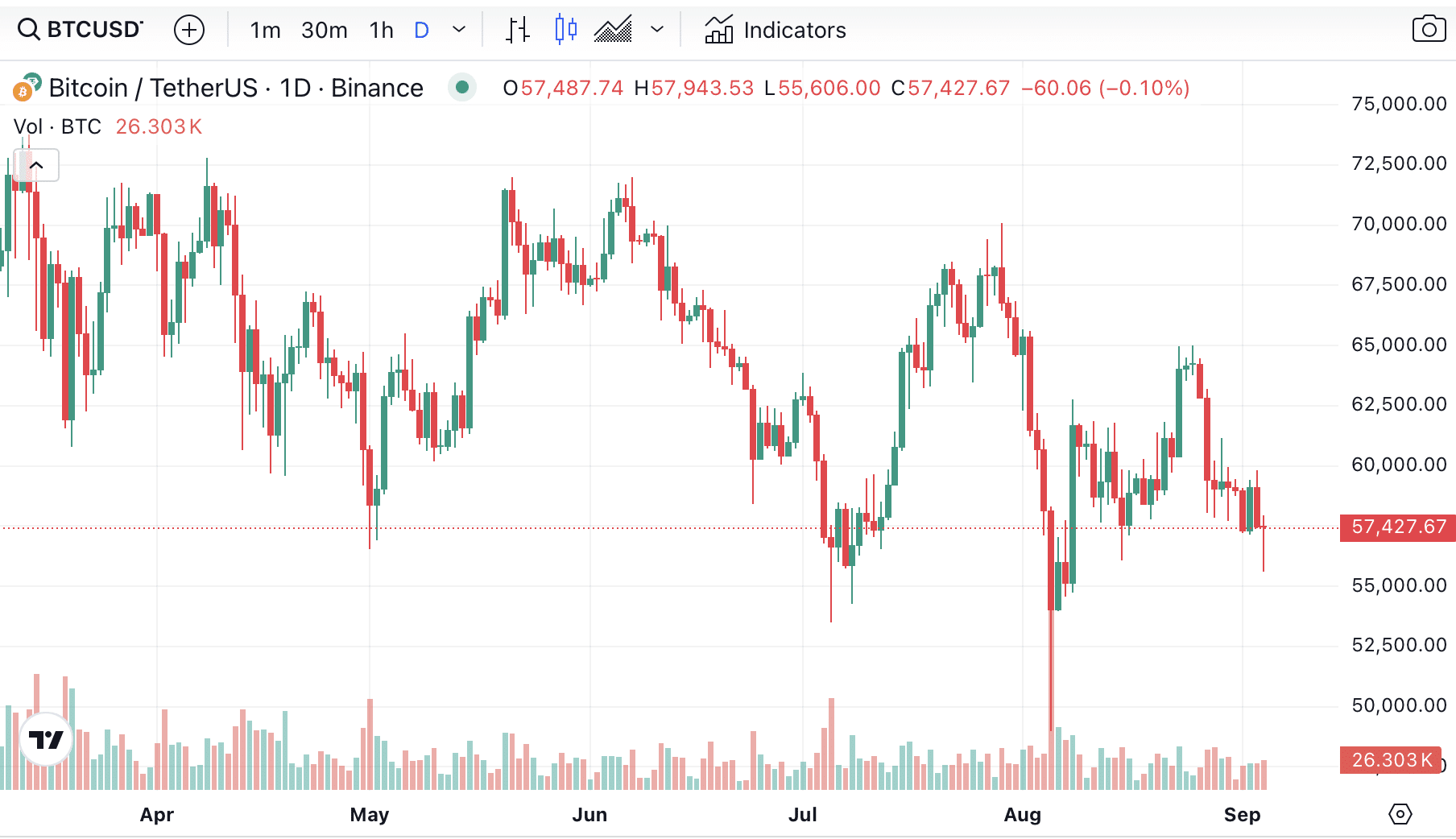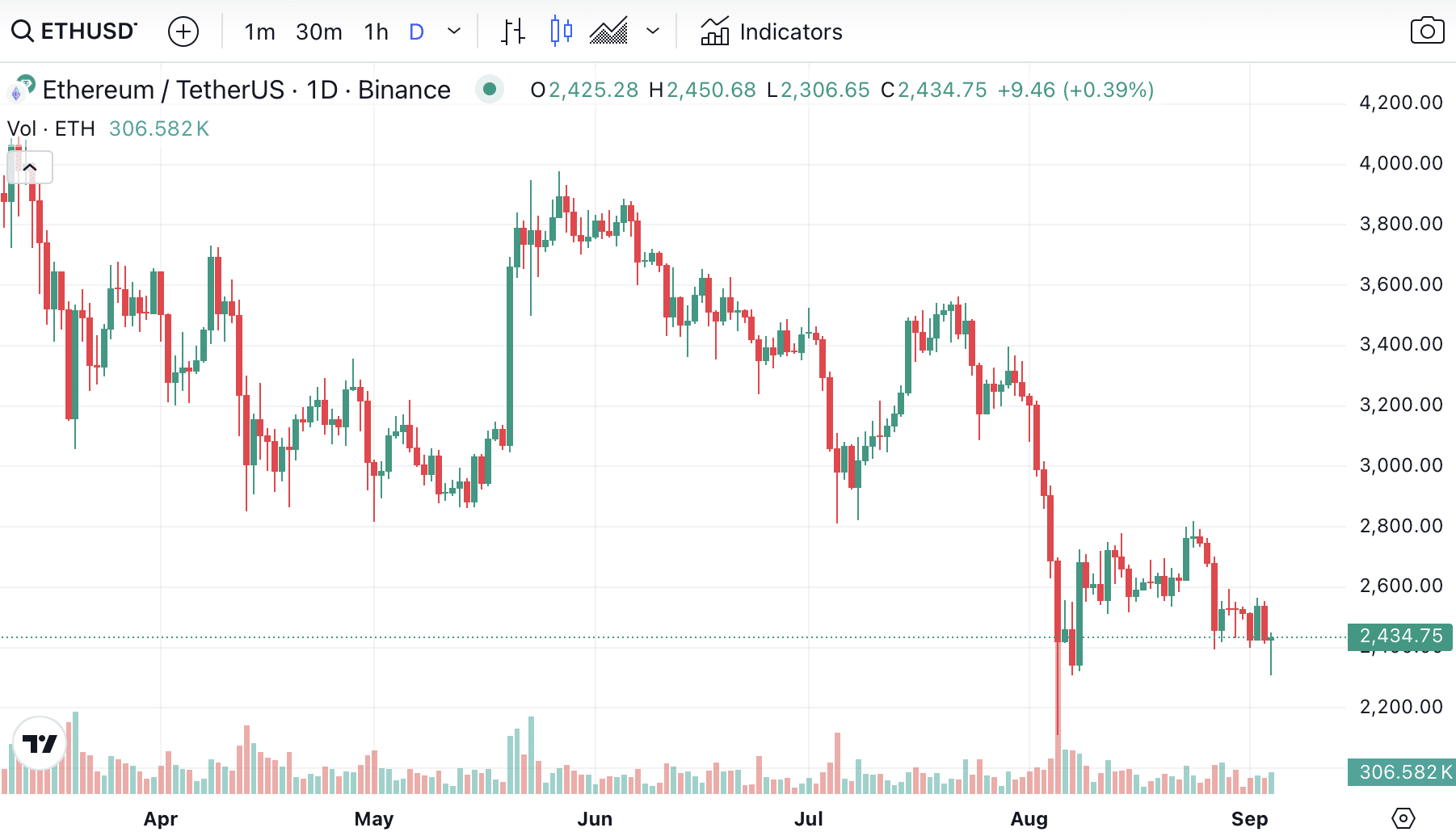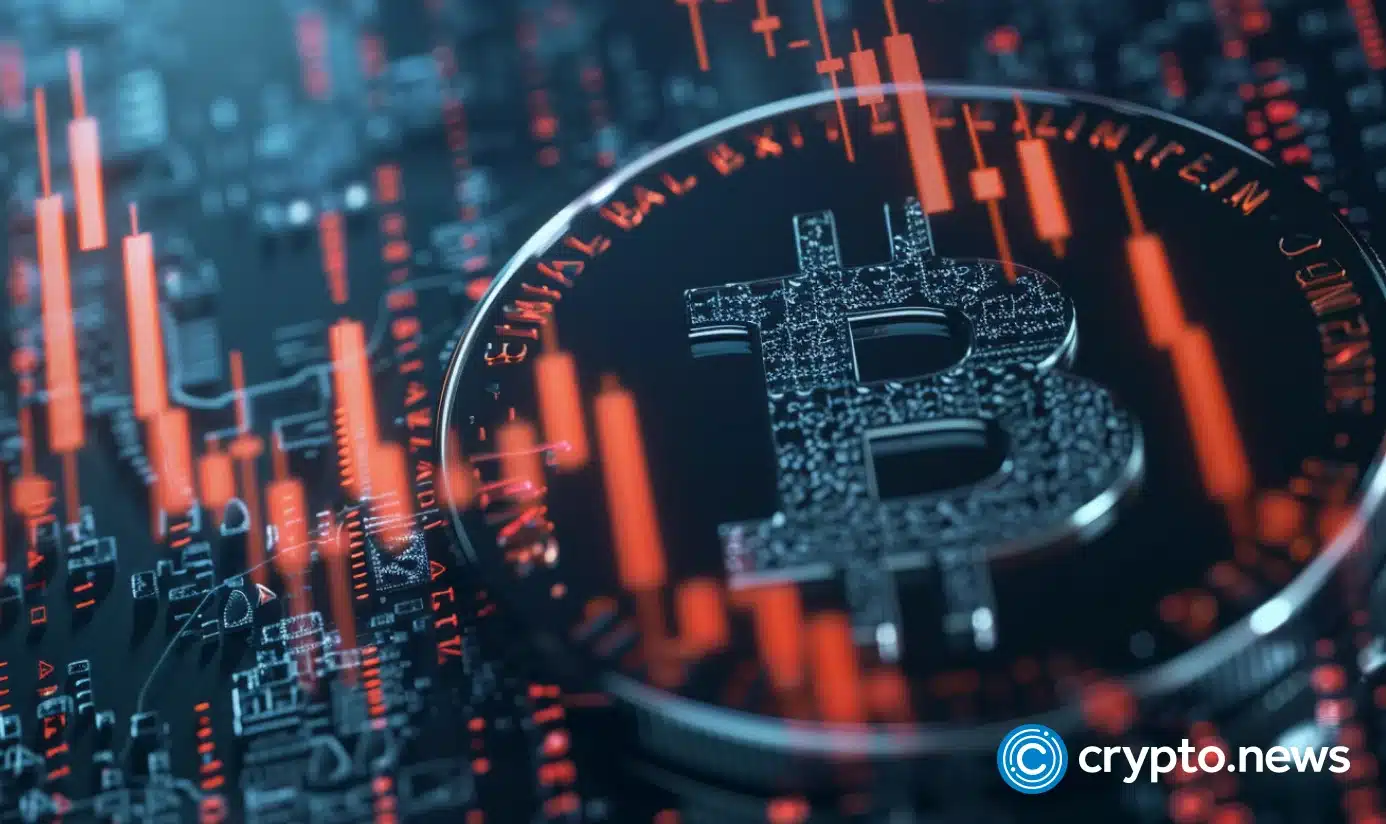Is Bitcoin on the verge of a major breakout, or will September’s economic indicators confirm the bearish sentiment that has kept the market in limbo for weeks?
Bitcoin waiting for its next signal
For the past few weeks, the crypto market has been treading water, with prices stubbornly stuck in a tight range.
Bitcoin (BTC) has been hovering around the $60,000 mark, often dipping just below it and struggling to maintain any momentum above this level. As of Sep. 3, BTC is trading at approximately $57,500, a level it has repeatedly revisited over the past month.

Similarly, Ethereum (ETH) has found a strong resistance at $2,500, barely budging from this range despite attempts to break through, trading at $2,450 levels as of this writing.

This sideways price action has left many investors and traders on edge, especially as we head into September — a month packed with critical events that could strongly influence the market’s direction.
Among these are the U.S. Presidential Debate, the Consumer Price Index (CPI) data release, the Producer Price Index (PPI) data release, and the Federal Open Market Committee meeting.
The CPI and PPI data are particularly important because they will likely play a key role in the Federal Reserve’s upcoming interest rate decision. If inflationary pressures appear to be easing, the Fed might opt for a rate cut.
With so much on the horizon, let’s dive deeper to understand what to expect, the likely repercussions, and where things could go from here.
The inflation indicators steering the Fed’s next move
The U.S. CPI and PPI are two of the most critical economic indicators that could influence the Fed’s interest rate decision this month. Understanding these numbers is key to grasping how the market might react in the coming weeks.
The CPI data for August, set to be released on Sep. 11, is a crucial measure of inflation, tracking how prices for everyday goods and services change over time.
In July, CPI inflation was at 2.9%, slightly down from 3% in June, suggesting a gradual cooling of inflation. However, the Fed’s goal is to bring inflation down to 2%, so the August CPI figure will be closely watched.
If this number drops below 2.9%, it would signal that inflation is moving in the right direction, potentially easing the pressure on the Fed to maintain high-interest rates.
The following day, on Sep. 12, the PPI data will be released. The PPI measures the average change in selling prices received by domestic producers for their output, offering insight into the inflationary pressures within the supply chain.
In July, the PPI showed a more stark reduction than anticipated, with the year-on-year rate falling to 2.2%, well below the previous period’s 2.7%.
Core PPI, which excludes volatile food and energy prices, also saw a sharp decline, coming in at 2.4% year-on-year compared to the expected 2.7%.
The importance of these inflation measures cannot be understated, as they will heavily influence the Fed’s decision on interest rates during the upcoming FOMC meeting on Sep.18.
In the previous meeting, the Fed opted to keep rates steady, with the current target range set between 5.25% and 5.50%. However, Fed Chair Jerome Powell has hinted that the central bank is nearing the end of its rate-hiking cycle, provided inflation continues to ease.
According to the CME FedWatch Tool, the market is currently split, with 67% expecting a 25 basis point cut to a new target rate of 5.00-5.25%, and 33% anticipating a more substantial 50 basis point cut, bringing the rate down to 4.75-5.00%.
A 25 basis point cut would likely signal that the Fed is entering a typical easing cycle, which could provide stability to the market.
On the other hand, a more aggressive 50 basis point cut might trigger an immediate surge in Bitcoin prices as investors react to the potential for lower borrowing costs and a more accommodative monetary policy.
The second presidential debate: a turning point?
As the second U.S. Presidential Debate approaches on Sep. 10, the crypto market is bracing for potential shifts in sentiment and direction.
This debate will be particularly significant for the crypto community, as it brings together two candidates with starkly different histories and perspectives on the industry.
On one side, we have Republican nominee Donald Trump, who has taken a surprisingly pro-crypto stance during this campaign.
Just a few years ago, Trump referred to Bitcoin as a “scam” and voiced concerns about its threat to the U.S. dollar. However, in a dramatic reversal, he has now become a vocal advocate for the crypto industry.
In a keynote speech at the Bitcoin conference in Nashville, Trump promised to fire SEC Chair Gary Gensler—a figure widely criticized within the crypto community. He also unveiled his plan to create a national Bitcoin strategic reserve and pledged support for U.S. crypto miners.
These bold promises have positioned Trump as a candidate who could potentially bring about big changes in how the U.S. government interacts with the crypto industry.
On the other side, Vice President Kamala Harris has remained relatively quiet on the subject of crypto throughout her campaign, leading to much speculation about her stance.
However, recent comments from her senior campaign adviser, Brian Nelson, have shed some light on her views. Nelson indicated that Harris intends to support policies that allow emerging technologies, including crypto, to continue to grow. While the statement was vague, it marks the first official acknowledgment of the crypto industry from the Harris camp.
The timing of these statements is critical, especially as the Democratic Party’s latest document didn’t mention crypto at all—a fact that hasn’t gone unnoticed by the industry.
This omission, combined with Harris’ recent comments, has led to mixed interpretations. Some see it as a positive sign, suggesting a hands-off approach, while others view it as a continuation of the Biden administration’s policies, which have been seen as less favorable to the crypto industry.
Additionally, recent backlash over misinformation regarding Harris’ alleged support for taxing unrealized capital gains has further clouded perceptions. Although this rumor was unfounded, it raised concerns within the crypto community, further obscuring her position.
Meanwhile, the debate is set against a backdrop of increased regulatory scrutiny, with the SEC recently issuing a Wells Notice to NFT marketplace OpenSea, signaling potential legal action.
In this context, Trump’s recent moves, such as announcing a new set of digital trading cards — ironically listed on OpenSea — have further solidified his pro-crypto image.
The timing of this notice has fueled speculation that a Harris administration might maintain or even intensify regulatory pressure on the crypto industry.
For crypto investors, a strong performance from Trump is likely to be seen as a bullish signal, given his clear pro-crypto stance and promises of deregulation.
Conversely, a Harris victory in the debate might be more challenging to interpret. While her recent comments suggest a willingness to support the industry, the lack of specific policy details and the ongoing regulatory actions raise questions about what a Harris administration would mean for crypto.
Where could the crypto market head next?
As the crypto market stands at a critical juncture, many experts are weighing in on where things could go from here.
One such indicator comes from Santiment, a well-known crypto market analytics platform, which recently highlighted that Bitcoin is showing signs of life.
Santiment observed that as fear, uncertainty, and doubt (FUD) grow among traders, particularly with a noticeable increase in bearish sentiment, there’s a chance that this pessimism could actually set the stage for a rebound. In other words, when everyone starts feeling bearish, it might be the perfect time for the market to bounce back.
Adding to this cautious optimism, crypto analyst Ali Charts pointed out that top Bitcoin traders on Binance are leaning slightly bullish, with over 51% holding long positions on BTC.
This tilt towards optimism, even if slight, suggests that traders are not entirely convinced that the recent market lull will lead to a prolonged downturn. It reflects a belief that the worst may be over and that Bitcoin could be poised for a recovery.
However, the broader economic backdrop remains a concern. The Kobeissi Letter recently highlighted a worrying trend in U.S. employment data.
Government hiring is inflating job numbers, while private sector job growth as a percentage of total payroll growth has dropped to its lowest level since the 2020 pandemic.
Historically, when private payroll growth falls below 40%, the U.S. economy has often been on the brink of a recession. This suggests that while the government is adding jobs at a record pace, the private sector is struggling, which could have negative implications for the economy — and, by extension, the crypto market.
Therefore, the upcoming CPI and PPI data will be crucial in shaping the Fed’s decision on interest rates during the FOMC meeting. If inflation continues to ease, the Fed may cut rates, boosting the crypto market.
Whether we see a bullish breakout or increased volatility will depend on how these political, economic, and market factors play out in the coming weeks. The decisions made and the data revealed this month will be critical in setting the course for where crypto is headed next.
Disclosure: This article does not represent investment advice. The content and materials featured on this page are for educational purposes only.

